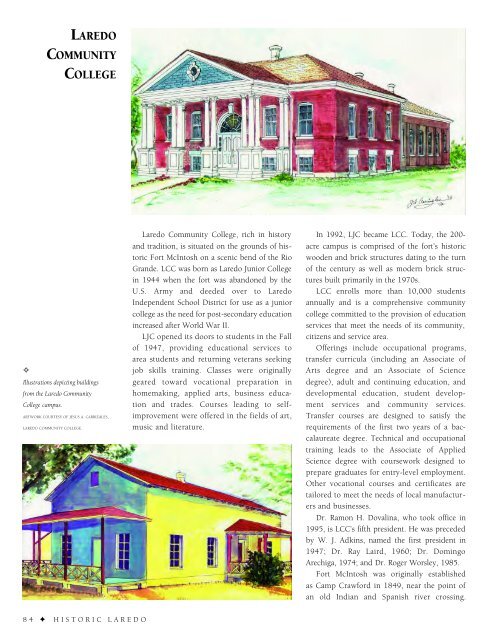Historic Laredo
An illustrated history of the city of Laredo and the Webb County area, paired with the histories of companies, families and organizations that make the region great.
An illustrated history of the city of Laredo and the Webb County area, paired with the histories of companies, families and organizations that make the region great.
You also want an ePaper? Increase the reach of your titles
YUMPU automatically turns print PDFs into web optimized ePapers that Google loves.
LAREDO<br />
COMMUNITY<br />
COLLEGE<br />
✧<br />
Illustrations depicting buildings<br />
from the <strong>Laredo</strong> Community<br />
College campus.<br />
ARTWORK COURTESY OF JESUS A. CARRIZALES,<br />
LAREDO COMMUNITY COLLEGE.<br />
<strong>Laredo</strong> Community College, rich in history<br />
and tradition, is situated on the grounds of historic<br />
Fort McIntosh on a scenic bend of the Rio<br />
Grande. LCC was born as <strong>Laredo</strong> Junior College<br />
in 1944 when the fort was abandoned by the<br />
U.S. Army and deeded over to <strong>Laredo</strong><br />
Independent School District for use as a junior<br />
college as the need for post-secondary education<br />
increased after World War II.<br />
LJC opened its doors to students in the Fall<br />
of 1947, providing educational services to<br />
area students and returning veterans seeking<br />
job skills training. Classes were originally<br />
geared toward vocational preparation in<br />
homemaking, applied arts, business education<br />
and trades. Courses leading to selfimprovement<br />
were offered in the fields of art,<br />
music and literature.<br />
In 1992, LJC became LCC. Today, the 200-<br />
acre campus is comprised of the fort’s historic<br />
wooden and brick structures dating to the turn<br />
of the century as well as modern brick structures<br />
built primarily in the 1970s.<br />
LCC enrolls more than 10,000 students<br />
annually and is a comprehensive community<br />
college committed to the provision of education<br />
services that meet the needs of its community,<br />
citizens and service area.<br />
Offerings include occupational programs,<br />
transfer curricula (including an Associate of<br />
Arts degree and an Associate of Science<br />
degree), adult and continuing education, and<br />
developmental education, student development<br />
services and community services.<br />
Transfer courses are designed to satisfy the<br />
requirements of the first two years of a baccalaureate<br />
degree. Technical and occupational<br />
training leads to the Associate of Applied<br />
Science degree with coursework designed to<br />
prepare graduates for entry-level employment.<br />
Other vocational courses and certificates are<br />
tailored to meet the needs of local manufacturers<br />
and businesses.<br />
Dr. Ramon H. Dovalina, who took office in<br />
1995, is LCC’s fifth president. He was preceded<br />
by W. J. Adkins, named the first president in<br />
1947; Dr. Ray Laird, 1960; Dr. Domingo<br />
Arechiga, 1974; and Dr. Roger Worsley, 1985.<br />
Fort McIntosh was originally established<br />
as Camp Crawford in 1849, near the point of<br />
an old Indian and Spanish river crossing.<br />
84 ✦ HISTORIC LAREDO
















